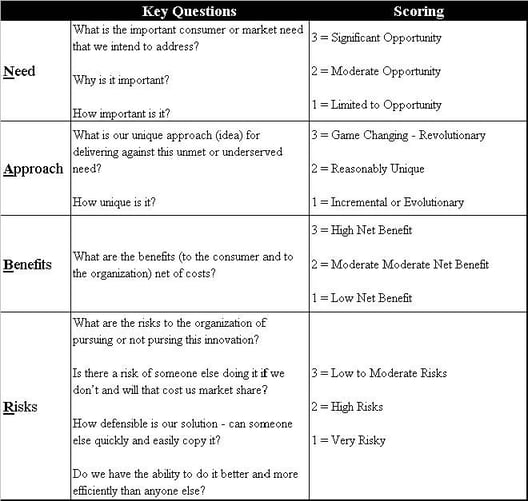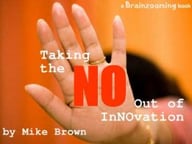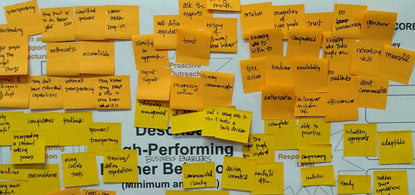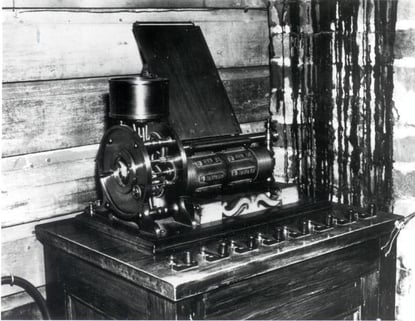Last week, frequent Brainzooming guest blogger Woody Bendle was tweeting some interesting thinking about innovation for higher education. Knowing I'd be at The Big Ideas in Higher Education conference today, I asked Woody to write up his full perspective to share with you (especially if you have children in or on their ways to college) and conference attendees as well.
Continuous Innovation for Higher Education by Woody Bendle
I was on the way into my office last week listening to NPR, and a story discussed the daunting employment and debt challenges of many recent college graduates. The statistics are frankly staggering!
- The average total cost (tuition, room, board) for a four year education across all US institutions is in excess of $84,000 according to the National Center for Educational Statistics. This is up 72% over the past 20 years – in real dollars.
- 60% of college students take on debt in excess, on average, of $20,000 as reported by Rutgers University, Heldrich Center for Workforce Development (pdf link).
- The Federal Reserve Bank of New York reports student loan debt is rapidly approaching $1 Trillion – and is greater than total US credit card debt ($703 Billion) and is more than the total owed on automobile loans ($734 Billion).
- The unemployment rate for recent college graduates is 8.9% - higher than the national average according to the Georgetown University Center on Education and the Workforce.
- The National Center for Higher Education Management Systems states 55% of all freshmen entering a four-year college graduate within six years.
I’m guessing I am not the only person amazed by these statistics. And, I honestly shouldn’t be entirely amazed as I am currently supporting two students who attend public university. But these figures definitely caught my attention!
Well… so what?!
A Process for Continuous Innovation for Higher Education
I look at the above data and acknowledge the magnitude of the challenge, yet think to myself, what an incredible opportunity for innovation!
Rather than jumping in and offering a bunch of ideas (opinions) about ways Higher Education institutions might do things differently, it is important to step back and think about this innovation challenge in a more methodical, proven manner.
Innovation isn’t just about coming up with a bunch of new “cool ideas” and tossing the proverbial spaghetti at the wall to see what sticks. It is commonly accepted that the failure rate of this approach to innovation is typically between 70-90%. Innovation is a process, and following a process, the odds of coming up with and implementing successful innovations can be greatly enhanced.
In a prior Brainzooming article, Continuous Innovation and Continuous Improvement, I introduced a three-stage process for continuous innovation - i3 Continuous Innovation:
1. Identify - Opportunities for new products or services
2. Innovate - And create new products or services
3. Implement - And scale
Let’s focus on the first stage, Identify as we think about Innovation in Higher Education. I’ll leave Stages 2 and 3 – Innovate, and Implement, for a later discussion.
The Identify stage of the i3 Continuous Innovation process is comprised of three sequential steps:
1. Identify the need
2. Come up with ideas
3. Evaluate the ideas
OK, so I’ve already offered up my opinion that there is a likely need for innovating Higher Education, but that isn’t exactly what Identify the need actually means in the i3 Continuous Innovation process.
Identify the Need through “Jobs to Be Done”
The i3 Continuous Innovation process purposefully starts with Identify the need.
One of the most valuable ways I’ve found to think bout this is by leveraging the Jobs to be done approach to innovation. Jobs to be done - first formally introduced by Clayton Christensen and Michael Raynor in their book The Innovator’s Solution - is “based on the notion that customers ‘hire’ products to do specific ‘jobs.’ The classic reference for this concept comes from Harvard professor, Theodore Levitt: “People don’t want to buy a quarter-inch drill. They want a quarter-inch hole!” In other words, people don’t need a drill, they need a hole; and the drill is the solution for their need. With this in mind, the questions we need to ask are:
- What ‘job’ does a college or university help a student ‘get done?’ (or What is it that a college ultimately helps a student do?)
- What ‘job’ is a college being ‘hired’ for?
While Colleges and Universities serve many constituents beyond students and provide exceptionally valuable benefits for many different consumers’ needs, let’s focus on what students need from Colleges and Universities.
Tony Ulwick in What Customers Want provides instructive clarity to the Jobs to be Done approach for innovation. Ulwick states: “To figure out what customers want and to successfully innovate, companies must think about customer requirements very differently. Companies must be able to know, well in advance, what criteria customers are going to use to judge a products value and dutifully design a product that ensures those criteria are met. These criteria must be predictive of success and not lagging indicators.”
Relative to Higher Education within Ulwick’s approach, think of:
- Colleges and Universities as the Companies
- Students as the Customer
- Degrees (or education) as the Products.
In order for Colleges and Universities to develop new highly valued innovative degrees and/or education, they first have to deeply understand the core student need.
Why Do Students Hire Colleges or Universities?
So…why do students ‘hire’ Colleges or Universities and rack up so much debt? Fundamentally, I feel students hire them to obtain skills and capabilities valued by employers, that enable them to either get an intellectually, emotionally and/or financially rewarding job - or start a successful business.
Maybe not every student thinks this way as they are entering or attending college, but I have to believe at some point, this is in fact the desired outcome from attending college and obtaining an education.
With this as our central job statement for Higher Education, we now have a solid foundation to begin the process of thinking about relevant innovation opportunities. First, however, we have to identify all the things that prevent or get in the way of students getting the job done. Examples of this might include:
- Not being able to pay for college
- Not wanting to rack up a mountain of debt to get a college education
- Not knowing what job / degree they really want
- Not knowing what college would be ‘right’ for them
- Missing classes
- Not understanding the professor or TA
- Not handing in assignments
- Not being sufficiently prepared for a given class
- Failing exams
- Not having the ability to apply the class knowledge
- Not having any relevant work experience
- Not having a degree / education that is valued by employers
- etc…
Typically, any given core ‘job’ will have between 75-150 challenges or obstacles that prevent the job executor (in this case, a student) from getting it done in a highly satisfactory way. Once all of these are known and prioritized, based on the legitimate opportunity indicated by the market, we can move onto the next step which is:
Come up with Ideas
Let’s assume our Jobs to be done and opportunity evaluation identified two highly significant obstacles for successfully accomplishing the job:
- Not having the ability to apply class knowledge
- Not having any relevant work experience
By ‘significant’ I mean something deemed very important by a large portion of the market (students) and not presently perceived to be well satisfied by the market (institutions of Higher Education).
Reworded, these become the following ‘needs:’
- Be able to apply class knowledge
- Have relevant work experience
With these two primary needs identified, we can now focus on coming up with possible ideas for solving these two very specific problems.
There are many approaches for generating ideas for possible solutions; some good, some not so good. Two references I particularly like for approaches to generating ideas are:
In addition, my good friends from The Brainzooming Group have an exceptionally good approach for helping organizations identify game changing innovative ideas and concepts.
Some consistent themes, however, for successful idea generation are:
- Start with an objective, or a specific challenge
- Utilize diverse perspectives and information, customer, market, industry, technology, etc
- Include people in your idea sessions with diverse backgrounds and professions
- In the beginning stages, all ideas are good – the more the better
- Don’t shut down ideas – let them flow, keep them coming and encourage more
- Don’t worry about viability at this point in the process
Thinking back to the needs we are assuming as significant opportunities for innovation in Higher Education, we can come up with dozens of ideas about how Colleges and Universities might uniquely provide solutions for these needs. Examples include:
- Integrate some institutions (or departments within some institutions) into corporations or organizations
- Incorporate practical, hands-on internships throughout the entire degree program
- Require a minimum of a six months internship with an applied, full scale project prior to graduating
- Require more “real world” problem solving into the curriculum
- Have Colleges and Universities function similarly to the farm leagues in baseball
- Structure collections of courses within and across semesters designed to support teams of students working on collaborative projects with substantial goals
- Organize academics more like college sports with regular academic competitions and championships
- No up front tuition - have tuition be a small fixed proportion of a student’s post-college salary or income – for a set period of time (i.e., 20 years)
- etc…
Evaluate the Ideas
You could likely have a hundred ideas ranging from ridiculous and naïve to very complicated and expensive, to simple and elegant. The objective here is to group all ideas into themes and begin determining which ideas to discard and which ideas to retain for consideration. A method I particularly like for this is NABR (pronounced, neighbor); which stands for Needs, Approach, Benefits, Risks. NABR is my twist on the NABC (Needs, Approach, Benefits, Competition) approach introduced by Curtis Carlson and William Wilmot in their 2006 book Innovation. NABR is an effective tool for quickly filtering ideas at a 30,000 foot level plus a solid framework for developing a full business case.
In terms of a high-level evaluation, I’ve found it useful to utilize the following NABR assessment template.
At this point in the innovation process, we’re only trying to determine which one or two ideas are worth moving forward to the next stage of the i3 Continuous Innovation process, which is Innovate.
We have not performed a rigorous business case analysis because we don’t even have a fully thought out solution to address the need. But, from diligently following the three steps of the Identify stage of the i3 Continuous Innovation process, we have confidence the proposed idea for innovating Higher Education will:
- Address a legitimate need in the marketplace;
- Which is currently perceived to be unmet or underserved; and
- We are uniquely positioned to deliver a valuable solution to the market.
While I willingly admit I currently do not have the answers for what innovations might be most wanted or needed in Higher Education, I will enthusiastically be among the first for offer assistance should I receive a call from Education Secretary Duncan. I’m truly passionate about both Innovation and Education and feel the application of the i3 Continuous Innovation process could help change the Higher Education game in extraordinary ways. - Woody Bendle
Download the free ebook, “Taking the NO Out of InNOvation” to help you generate fantastic creative ideas! For an organizational creativity boost, contact The Brainzooming Group to help your team be more successful by rapidly expanding strategic options and creating innovative plans to efficiently implement. Email us at info@brainzooming.com or call us at 816-509-5320 to learn how we can deliver these benefits for you.






